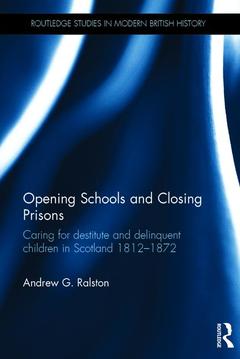Opening Schools and Closing Prisons Caring for destitute and delinquent children in Scotland 1812–1872 Routledge Studies in Modern British History Series
Auteur : Ralston Andrew G.

The book covers the period from 1812, when the Tron Riot in Edinburgh dramatically drew attention to the ?lamentable extent of juvenile depravity?, up to 1872, when the Education Act (Scotland) inaugurated a system of universal schooling.
During the 1840s and 1850s in particular there was a move away from a punitive approach to young offenders to one based on reformation and prevention. Scotland played a key role in developing reformatory institutions ? notably the Glasgow House of Refuge, the largest of its type in the UK ? and industrial schools which provided meals and education for children in danger of falling into crime.
These schools were pioneered in Aberdeen by Sheriff William Watson and in Edinburgh by the Reverend Thomas Guthrie and exerted considerable influence throughout the United Kingdom. The experience of the Scottish schools was crucial in the development of legislation for a national, UK-wide system between 1854 and 1866.
List of Figures
Preface
Chapter 1:
Punishment, reformation and prevention: changing attitudes to juvenile crime in mid-nineteenth century Britain
Chapter 2:
‘The lamentable extent of youthful depravity’: the Tron Riot of 1812
Chapter 3:
Stirrings for change: developments in Edinburgh, 1812-1846
Chapter 4:
‘An intermediate step’: the Glasgow House of Refuge, 1838-1854
Chapter 5:
Prevention is better than cure: the Aberdeen industrial schools, 1841-1854
Chapter 6:
Ragged school rivalry: the Original versus the United Industrial School in Edinburgh, 1847-1854
Chapter 7:
‘A better model’: the influence of the Scottish approach in England
Chapter 8:
The formation of a national system (i): reformatory and industrial schools legislation, 1854-1872
Chapter 9:
The formation of a national system (ii): the effects of legislation on individual schools
Chapter 10:
Schooling for all: industrial schools and the 1872 Education Act
Chapter 11:
Change and continuity: nineteenth century approaches in context
Bibliography
Index
Andrew G. Ralston, a student at Glasgow University in the late 1970s, was encouraged by the late Geoffrey Finlayson, author of the definitive biography of Lord Shaftesbury, to take an interest in the history of the treatment of destitute and delinquent children in nineteenth-century Scotland. Having completed a degree of D.Phil at Balliol College, Oxford University, he has subsequently co-authored over twenty successful school textbooks.
Date de parution : 11-2016
15.6x23.4 cm
Date de parution : 06-2018
15.6x23.4 cm
Thèmes d’Opening Schools and Closing Prisons :
Mots-clés :
Young Men; North British Daily Mail; History since 1800; Frederic Hill; Victorian Britain; Juvenile Delinquency; Tron Riots; Industrial School; Juvenile Crime; Reformer Mary Carpenter; Glasgow House of Refuge; Mary Carpenter; United Industrial School; Parochial Boards; Alexander Thomson; Dunlop’s Act; William Watson; Ragged Schools; Scottish schools; Industrial Schools Act; Universal schooling; Juvenile Vagrancy; Social policy; Palmerston’s Act; Scotland's education act; Delinquents; Glasgow House; Nineteenth Century Scotland; Juvenile School; Juvenile Delinquency Commissioners; Voluntary Cases; Juvenile Delinquency Act; South Bridge; Edinburgh Police Act; Tron Church; Child’s Persuasion; Vagrant Children



